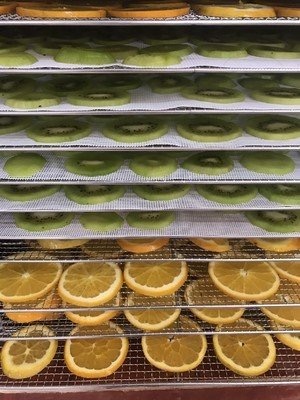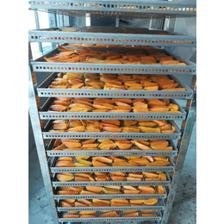
Content Menu
● Introduction
● What is a Food Dehydrator?
● How Do Food Dehydrators Work?
● Benefits of Using Food Dehydrators
>> 1. Nutritional Retention
>> 2. Extended Shelf Life
>> 3. Versatility
>> 4. Cost-Effective
>> 5. Healthy Snacking
● Comparing Food Dehydrators to Other Drying Methods
>> Air Drying
>> Sun Drying
>> Oven Drying
● Choosing the Right Food Dehydrator
>> Additional Features to Consider
● Maintenance Tips for Food Dehydrators
● Creative Uses for Dehydrated Foods
● Environmental Impact of Food Dehydration
● Conclusion
● Frequently Asked Questions
>> 1. What types of foods can I dehydrate?
>> 2. How long does it take to dehydrate foods?
>> 3. Can I use my oven instead of a dehydrator?
>> 4. Is it safe to dehydrate meat?
>> 5. How should I store dehydrated foods?
Introduction
In the world of food preservation, food dehydrators have emerged as a crucial tool for both home cooks and commercial food producers. As a leading manufacturer of food drying machines in China, we specialize in providing OEM services for international brands, wholesalers, and producers. Our focus on quality and innovation ensures that our clients receive the best products tailored to their specific needs. In this article, we will explore the benefits of food dehydrators, their working mechanisms, and how they compare to other drying methods, including the Hoover heat pump dryer.

What is a Food Dehydrator?
A food dehydrator is an appliance designed to remove moisture from food items, thereby inhibiting the growth of bacteria, yeast, and mold. This process extends the shelf life of various foods while retaining their nutritional value. Food dehydrators come in various shapes and sizes, from small countertop models to large industrial machines.
How Do Food Dehydrators Work?
Food dehydrators operate on a simple principle: they circulate warm air around the food to evaporate moisture. Most models use a fan and heating element to achieve this. Here's a breakdown of the process:
1. Preparation: Foods are washed, sliced, and arranged on trays.
2. Heating: The dehydrator heats up to a preset temperature.
3. Air Circulation: A fan circulates warm air throughout the chamber.
4. Moisture Removal: As moisture evaporates, it is expelled from the unit.
This method is similar to how a Hoover heat pump dryer operates; both utilize heat and airflow to remove moisture efficiently.
Benefits of Using Food Dehydrators
1. Nutritional Retention
One of the significant advantages of using food dehydrators is their ability to retain nutrients. Unlike traditional cooking methods that can destroy vitamins and minerals, dehydrating maintains most of the food's nutritional profile. For instance, fruits like apples and bananas retain their vitamin C content when dried properly.
2. Extended Shelf Life
Dehydrated foods can last for months or even years when stored properly. This makes them ideal for long-term storage and emergency preparedness. For example, dried fruits can be stored for up to a year in airtight containers without losing flavor or texture.
3. Versatility
Food dehydrators can be used for various foods, including fruits, vegetables, herbs, meats, and even flowers for potpourri. You can create your own dried fruit snacks or vegetable chips at home without preservatives.

4. Cost-Effective
Investing in a food dehydrator can save money in the long run by allowing you to buy seasonal produce in bulk and preserve it for later use. This is particularly beneficial for families who want to reduce grocery bills while enjoying healthy snacks.
5. Healthy Snacking
Dehydrated snacks are often healthier than their store-bought counterparts, which may contain preservatives and added sugars. For instance, homemade apple chips can be seasoned with cinnamon instead of sugar for a delicious treat.
Comparing Food Dehydrators to Other Drying Methods
When it comes to drying food, several methods exist: air drying, sun drying, oven drying, and using machines like the Hoover heat pump dryer. Here's how they compare:
| Method | Pros | Cons |
|----------------------|----------------------------------------|----------------------------------------|
| Air Drying | Simple and cost-effective | Time-consuming; weather-dependent |
| Sun Drying | Natural method | Limited by climate; risk of contamination |
| Oven Drying | Faster than air/sun drying | High energy consumption; uneven results |
| Food Dehydrator | Controlled environment; efficient | Initial investment cost |
| Hoover Heat Pump Dryer | Energy-efficient; versatile | Primarily designed for laundry |
Air Drying
Air drying is one of the oldest methods of preserving food. It involves hanging or laying out food items in a well-ventilated area until moisture evaporates naturally. While this method requires no equipment or energy costs, it is highly dependent on weather conditions and can take several days.
Sun Drying
Sun drying is another traditional method that utilizes sunlight to dehydrate foods. This technique works well in hot climates but poses risks such as contamination from insects or animals and requires careful monitoring to prevent spoilage.
Oven Drying
Using an oven for drying foods can be effective but often leads to uneven results due to hot spots within the oven. Additionally, ovens consume more energy than dedicated dehydrators and may not provide the same level of control over temperature and airflow.
Choosing the Right Food Dehydrator
When selecting a food dehydrator, consider the following factors:
- Capacity: Choose a model that fits your needs—small units for home use or larger ones for commercial purposes.
- Temperature Control: Adjustable temperature settings allow you to dehydrate various foods optimally.
- Fan Placement: A rear-mounted fan provides even airflow compared to top-mounted fans.
- Ease of Cleaning: Look for models with removable trays that are dishwasher safe.
Additional Features to Consider
- Timer Functionality: Some advanced models come with built-in timers that allow you to set dehydration times without needing constant supervision.
- Automatic Shut-off: This feature prevents overheating and ensures safety by turning off the machine once dehydration is complete.
- Digital Controls: Digital displays make it easier to monitor temperature settings and remaining time.
Maintenance Tips for Food Dehydrators
To ensure your food dehydrator lasts and operates efficiently:
- Clean trays after each use with warm soapy water or place them in the dishwasher if they are dishwasher-safe.
- Regularly check heating elements and fans for dust buildup which can affect performance.
- Store in a dry place when not in use to prevent moisture accumulation inside the unit.
Creative Uses for Dehydrated Foods
Dehydrated foods are not just snacks; they can be used creatively in various recipes:
- Soups and Stews: Add dried vegetables like carrots and peas directly into soups; they will rehydrate during cooking.
- Trail Mixes: Combine dried fruits with nuts and seeds for a nutritious snack on-the-go.
- Homemade Granola Bars: Incorporate dried fruits into granola bars for added flavor and nutrition.
Environmental Impact of Food Dehydration
Using a food dehydrator also has positive environmental implications:
- Reduced Food Waste: By preserving surplus fruits and vegetables that might otherwise spoil, you contribute less waste to landfills.
- Sustainable Practices: Many home cooks choose organic produce for dehydration, supporting sustainable farming practices.
Conclusion
Food dehydrators are invaluable tools for anyone interested in preserving food effectively while maintaining its nutritional value. With various options available on the market today—including our high-quality OEM models from China—you can find a dehydrator that meets your specific needs. By understanding how these machines work and their benefits over other methods—like the Hoover heat pump dryer—you can make informed decisions about your food preservation techniques.
Investing in a food dehydrator not only enhances your culinary repertoire but also promotes healthier eating habits by allowing you to create delicious snacks without artificial additives or preservatives.

Frequently Asked Questions
1. What types of foods can I dehydrate?
You can dehydrate fruits, vegetables, herbs, meats (for jerky), mushrooms, nuts, seeds, pasta (for quick meals), and even flowers for potpourri.
2. How long does it take to dehydrate foods?
Dehydration times vary based on the type of food and thickness but typically range from 4 to 12 hours depending on moisture content and desired dryness level.
3. Can I use my oven instead of a dehydrator?
Yes! However, ovens may not provide consistent temperatures or airflow like dedicated dehydrators do; they also consume more energy over long periods.
4. Is it safe to dehydrate meat?
Yes! Ensure meat is cooked first (for jerky) before dehydration; follow safe dehydration practices including marinating meat properly before drying.
5. How should I store dehydrated foods?
Store in airtight containers in a cool, dark place away from sunlight; vacuum sealing is recommended for optimal preservation duration.
By exploring these aspects of food dehydrators thoroughly, we hope this guide will help you understand their importance in modern food preservation techniques while also highlighting our commitment to quality manufacturing in this field.












